check engine light FORD ESCAPE 2015 3.G User Guide
[x] Cancel search | Manufacturer: FORD, Model Year: 2015, Model line: ESCAPE, Model: FORD ESCAPE 2015 3.GPages: 449, PDF Size: 5.36 MB
Page 219 of 449
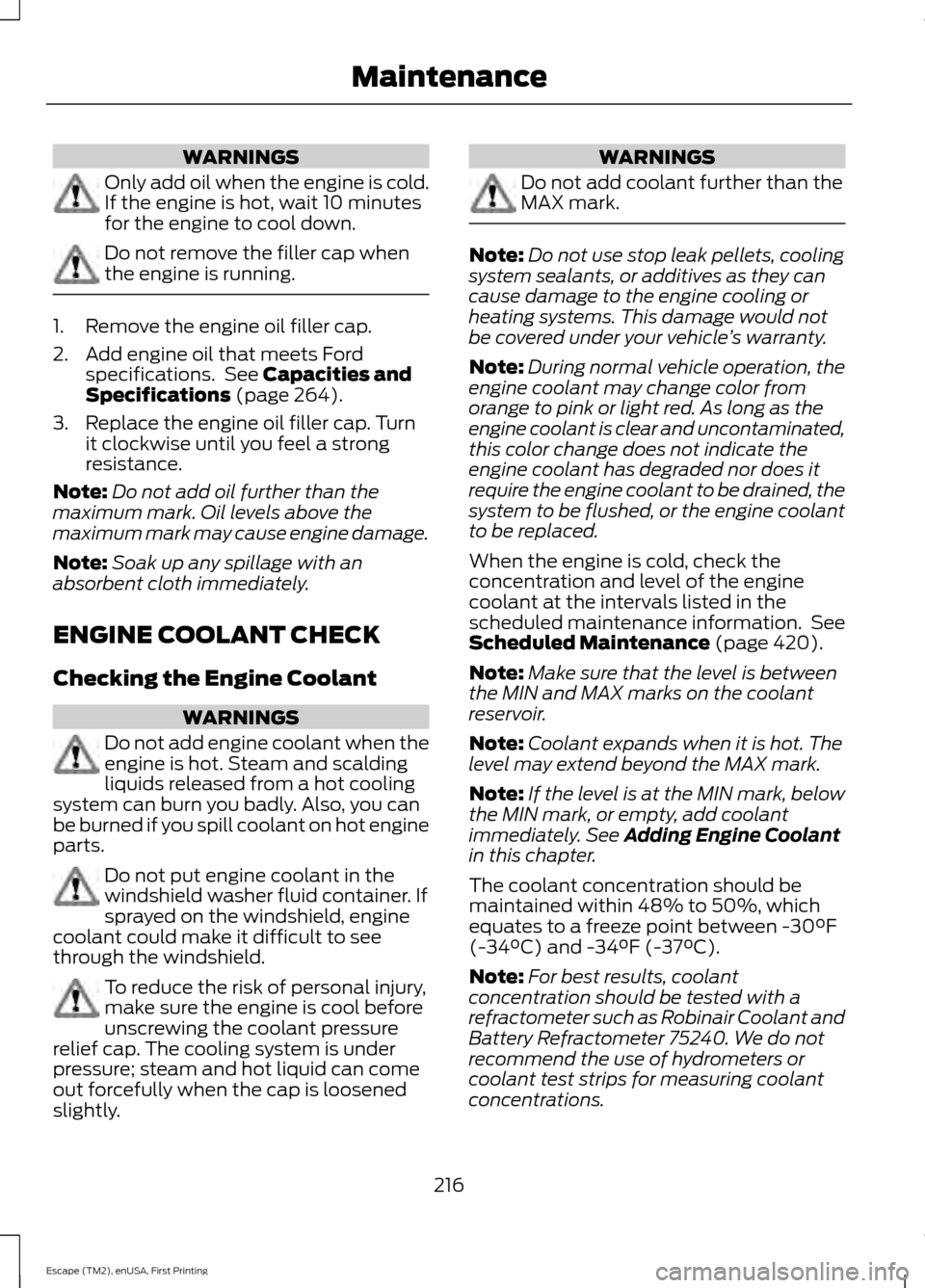
WARNINGS
Only add oil when the engine is cold.
If the engine is hot, wait 10 minutes
for the engine to cool down.
Do not remove the filler cap when
the engine is running.
1. Remove the engine oil filler cap.
2. Add engine oil that meets Ford
specifications. See Capacities and
Specifications (page 264).
3. Replace the engine oil filler cap. Turn it clockwise until you feel a strong
resistance.
Note: Do not add oil further than the
maximum mark. Oil levels above the
maximum mark may cause engine damage.
Note: Soak up any spillage with an
absorbent cloth immediately.
ENGINE COOLANT CHECK
Checking the Engine Coolant WARNINGS
Do not add engine coolant when the
engine is hot. Steam and scalding
liquids released from a hot cooling
system can burn you badly. Also, you can
be burned if you spill coolant on hot engine
parts. Do not put engine coolant in the
windshield washer fluid container. If
sprayed on the windshield, engine
coolant could make it difficult to see
through the windshield. To reduce the risk of personal injury,
make sure the engine is cool before
unscrewing the coolant pressure
relief cap. The cooling system is under
pressure; steam and hot liquid can come
out forcefully when the cap is loosened
slightly. WARNINGS
Do not add coolant further than the
MAX mark.
Note:
Do not use stop leak pellets, cooling
system sealants, or additives as they can
cause damage to the engine cooling or
heating systems. This damage would not
be covered under your vehicle ’s warranty.
Note: During normal vehicle operation, the
engine coolant may change color from
orange to pink or light red. As long as the
engine coolant is clear and uncontaminated,
this color change does not indicate the
engine coolant has degraded nor does it
require the engine coolant to be drained, the
system to be flushed, or the engine coolant
to be replaced.
When the engine is cold, check the
concentration and level of the engine
coolant at the intervals listed in the
scheduled maintenance information. See
Scheduled Maintenance
(page 420).
Note: Make sure that the level is between
the MIN and MAX marks on the coolant
reservoir.
Note: Coolant expands when it is hot. The
level may extend beyond the MAX mark.
Note: If the level is at the MIN mark, below
the MIN mark, or empty, add coolant
immediately. See
Adding Engine Coolant
in this chapter.
The coolant concentration should be
maintained within 48% to 50%, which
equates to a freeze point between -30°F
(-34°C) and -34°F (-37°C).
Note: For best results, coolant
concentration should be tested with a
refractometer such as Robinair Coolant and
Battery Refractometer 75240. We do not
recommend the use of hydrometers or
coolant test strips for measuring coolant
concentrations.
216
Escape (TM2), enUSA, First Printing Maintenance
Page 221 of 449
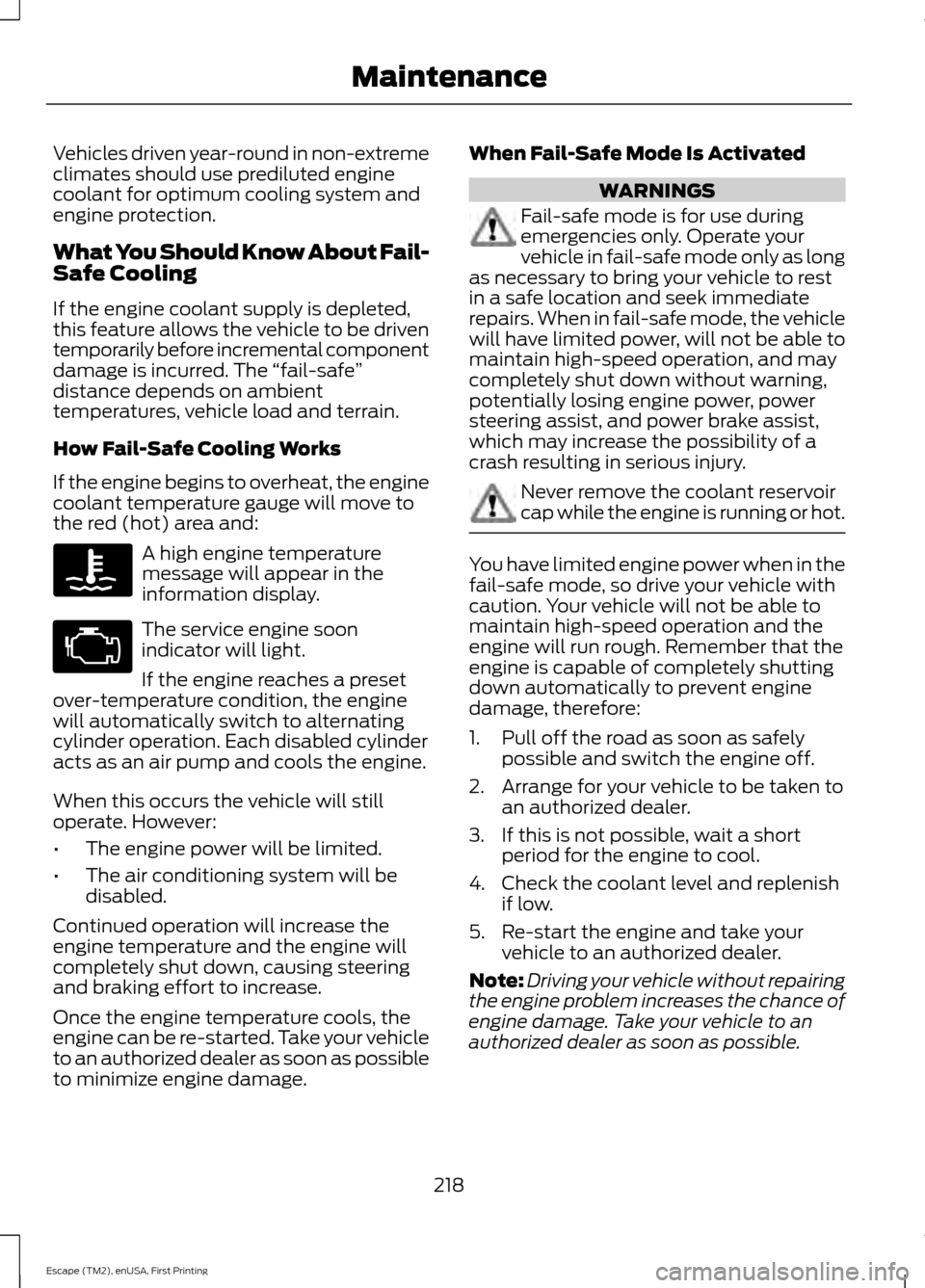
Vehicles driven year-round in non-extreme
climates should use prediluted engine
coolant for optimum cooling system and
engine protection.
What You Should Know About Fail-
Safe Cooling
If the engine coolant supply is depleted,
this feature allows the vehicle to be driven
temporarily before incremental component
damage is incurred. The
“fail-safe”
distance depends on ambient
temperatures, vehicle load and terrain.
How Fail-Safe Cooling Works
If the engine begins to overheat, the engine
coolant temperature gauge will move to
the red (hot) area and: A high engine temperature
message will appear in the
information display.
The service engine soon
indicator will light.
If the engine reaches a preset
over-temperature condition, the engine
will automatically switch to alternating
cylinder operation. Each disabled cylinder
acts as an air pump and cools the engine.
When this occurs the vehicle will still
operate. However:
• The engine power will be limited.
• The air conditioning system will be
disabled.
Continued operation will increase the
engine temperature and the engine will
completely shut down, causing steering
and braking effort to increase.
Once the engine temperature cools, the
engine can be re-started. Take your vehicle
to an authorized dealer as soon as possible
to minimize engine damage. When Fail-Safe Mode Is Activated WARNINGS
Fail-safe mode is for use during
emergencies only. Operate your
vehicle in fail-safe mode only as long
as necessary to bring your vehicle to rest
in a safe location and seek immediate
repairs. When in fail-safe mode, the vehicle
will have limited power, will not be able to
maintain high-speed operation, and may
completely shut down without warning,
potentially losing engine power, power
steering assist, and power brake assist,
which may increase the possibility of a
crash resulting in serious injury. Never remove the coolant reservoir
cap while the engine is running or hot.
You have limited engine power when in the
fail-safe mode, so drive your vehicle with
caution. Your vehicle will not be able to
maintain high-speed operation and the
engine will run rough. Remember that the
engine is capable of completely shutting
down automatically to prevent engine
damage, therefore:
1. Pull off the road as soon as safely
possible and switch the engine off.
2. Arrange for your vehicle to be taken to an authorized dealer.
3. If this is not possible, wait a short period for the engine to cool.
4. Check the coolant level and replenish if low.
5. Re-start the engine and take your vehicle to an authorized dealer.
Note: Driving your vehicle without repairing
the engine problem increases the chance of
engine damage. Take your vehicle to an
authorized dealer as soon as possible.
218
Escape (TM2), enUSA, First Printing Maintenance
Page 239 of 449
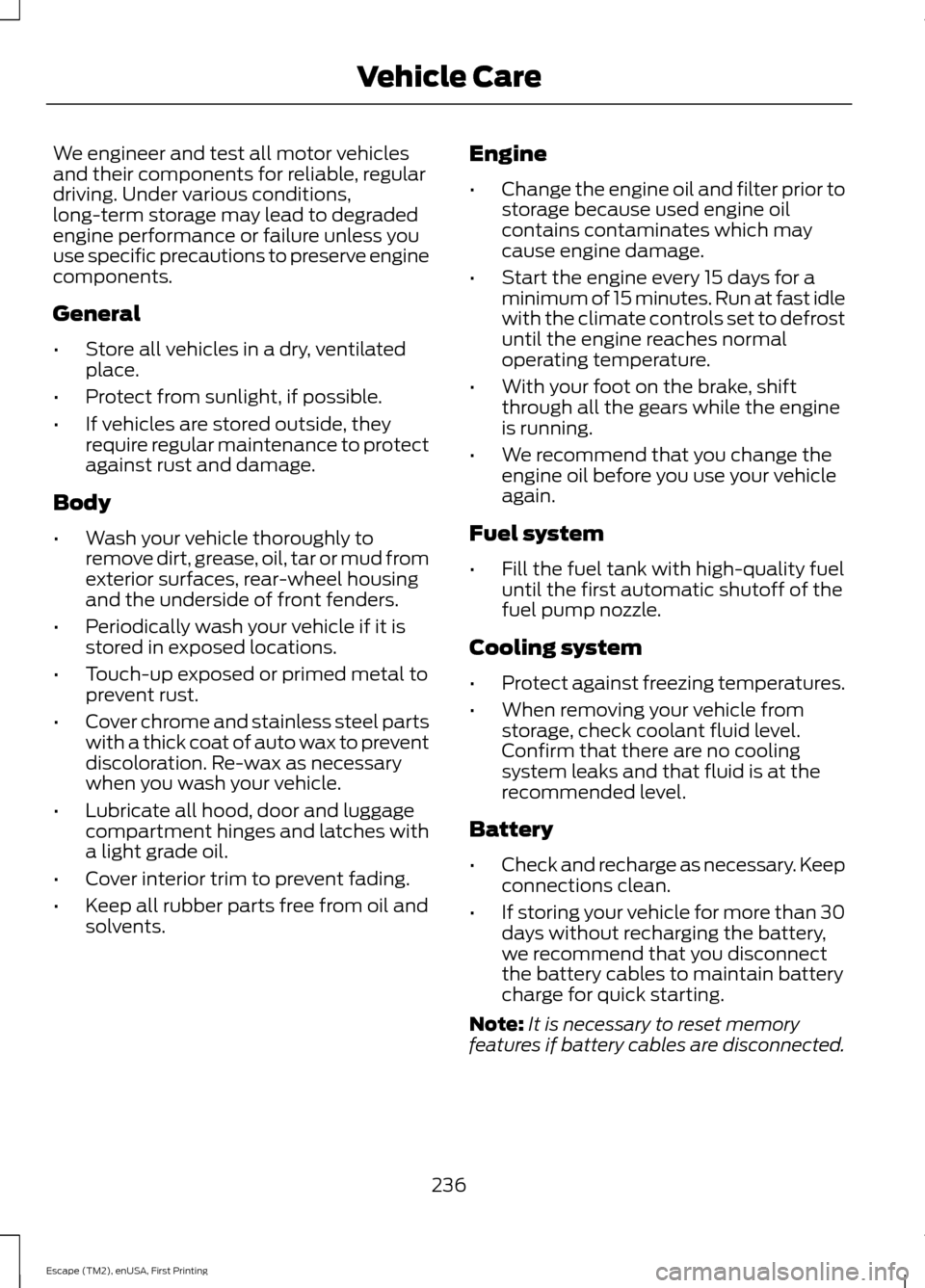
We engineer and test all motor vehicles
and their components for reliable, regular
driving. Under various conditions,
long-term storage may lead to degraded
engine performance or failure unless you
use specific precautions to preserve engine
components.
General
•
Store all vehicles in a dry, ventilated
place.
• Protect from sunlight, if possible.
• If vehicles are stored outside, they
require regular maintenance to protect
against rust and damage.
Body
• Wash your vehicle thoroughly to
remove dirt, grease, oil, tar or mud from
exterior surfaces, rear-wheel housing
and the underside of front fenders.
• Periodically wash your vehicle if it is
stored in exposed locations.
• Touch-up exposed or primed metal to
prevent rust.
• Cover chrome and stainless steel parts
with a thick coat of auto wax to prevent
discoloration. Re-wax as necessary
when you wash your vehicle.
• Lubricate all hood, door and luggage
compartment hinges and latches with
a light grade oil.
• Cover interior trim to prevent fading.
• Keep all rubber parts free from oil and
solvents. Engine
•
Change the engine oil and filter prior to
storage because used engine oil
contains contaminates which may
cause engine damage.
• Start the engine every 15 days for a
minimum of 15 minutes. Run at fast idle
with the climate controls set to defrost
until the engine reaches normal
operating temperature.
• With your foot on the brake, shift
through all the gears while the engine
is running.
• We recommend that you change the
engine oil before you use your vehicle
again.
Fuel system
• Fill the fuel tank with high-quality fuel
until the first automatic shutoff of the
fuel pump nozzle.
Cooling system
• Protect against freezing temperatures.
• When removing your vehicle from
storage, check coolant fluid level.
Confirm that there are no cooling
system leaks and that fluid is at the
recommended level.
Battery
• Check and recharge as necessary. Keep
connections clean.
• If storing your vehicle for more than 30
days without recharging the battery,
we recommend that you disconnect
the battery cables to maintain battery
charge for quick starting.
Note: It is necessary to reset memory
features if battery cables are disconnected.
236
Escape (TM2), enUSA, First Printing Vehicle Care
Page 425 of 449
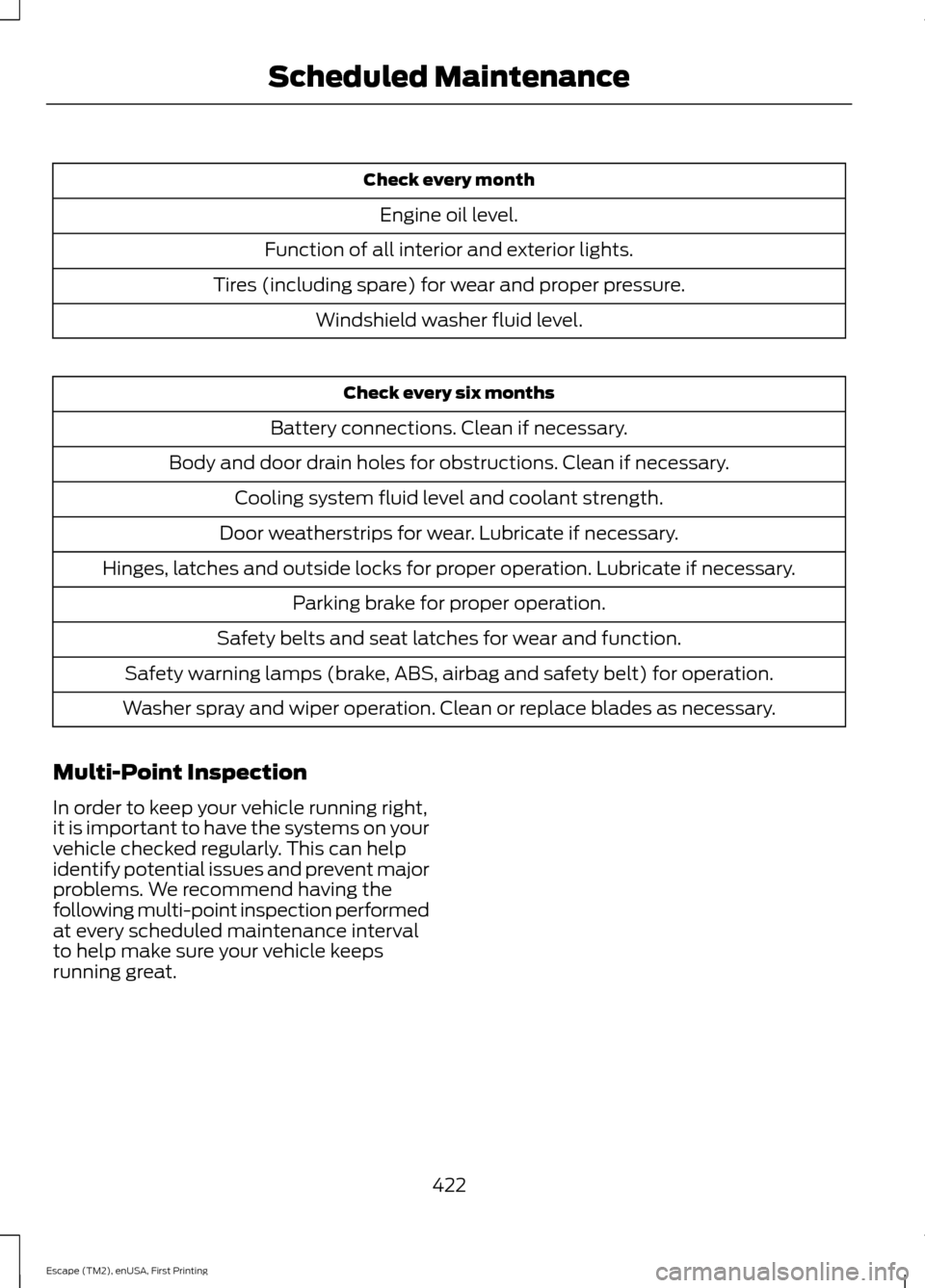
Check every month
Engine oil level.
Function of all interior and exterior lights.
Tires (including spare) for wear and proper pressure. Windshield washer fluid level. Check every six months
Battery connections. Clean if necessary.
Body and door drain holes for obstructions. Clean if necessary. Cooling system fluid level and coolant strength.
Door weatherstrips for wear. Lubricate if necessary.
Hinges, latches and outside locks for proper operation. Lubricate if necessary. Parking brake for proper operation.
Safety belts and seat latches for wear and function.
Safety warning lamps (brake, ABS, airbag and safety belt) for operation.
Washer spray and wiper operation. Clean or replace blades as necessary.
Multi-Point Inspection
In order to keep your vehicle running right,
it is important to have the systems on your
vehicle checked regularly. This can help
identify potential issues and prevent major
problems. We recommend having the
following multi-point inspection performed
at every scheduled maintenance interval
to help make sure your vehicle keeps
running great.
422
Escape (TM2), enUSA, First Printing Scheduled Maintenance
Page 430 of 449
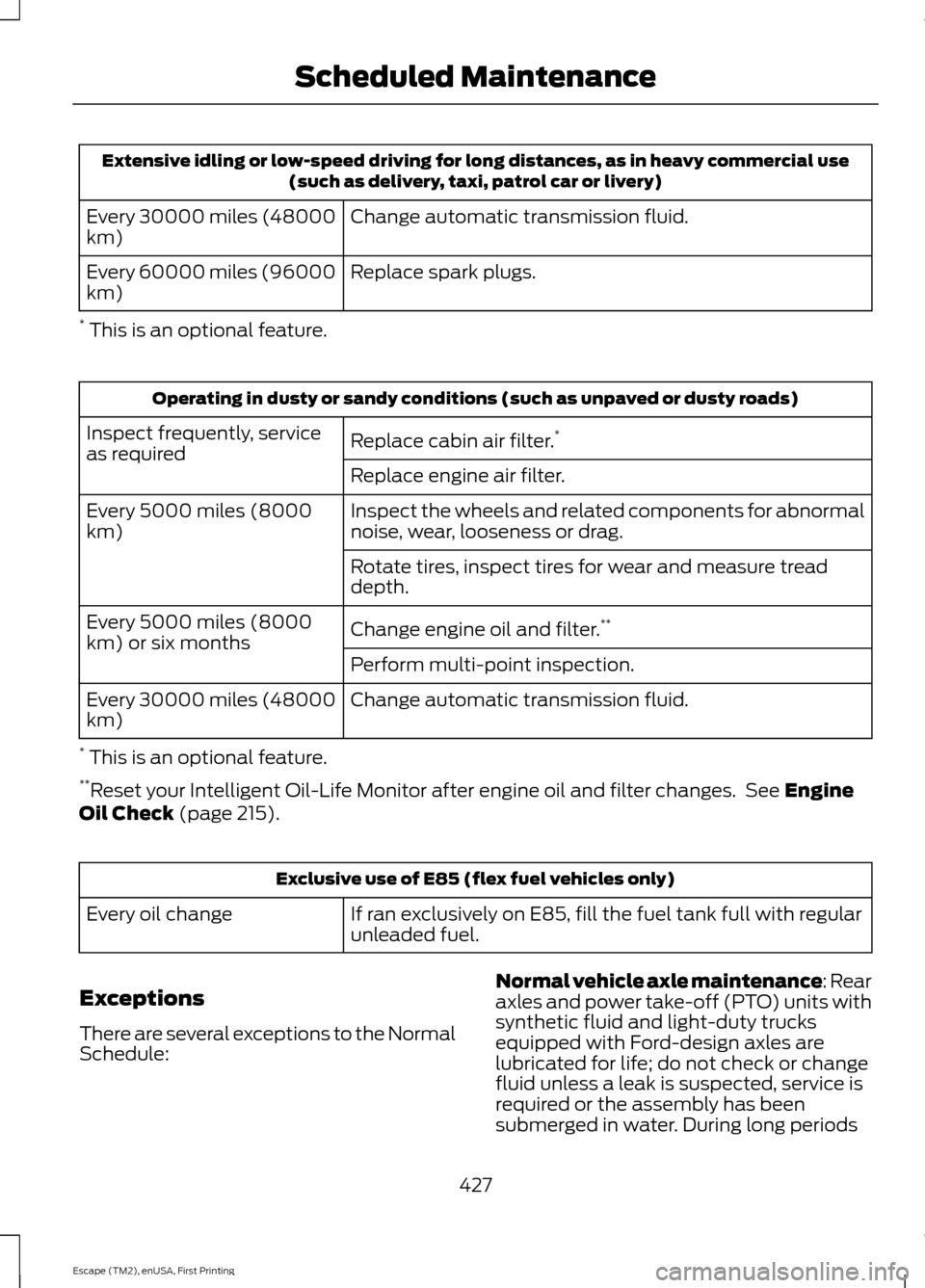
Extensive idling or low-speed driving for long distances, as in heavy commercial use
(such as delivery, taxi, patrol car or livery)
Change automatic transmission fluid.
Every 30000 miles (48000
km)
Replace spark plugs.
Every 60000 miles (96000
km)
* This is an optional feature. Operating in dusty or sandy conditions (such as unpaved or dusty roads)
Replace cabin air filter. *
Inspect frequently, service
as required
Replace engine air filter.
Inspect the wheels and related components for abnormal
noise, wear, looseness or drag.
Every 5000 miles (8000
km)
Rotate tires, inspect tires for wear and measure tread
depth.
Change engine oil and filter.**
Every 5000 miles (8000
km) or six months
Perform multi-point inspection.
Change automatic transmission fluid.
Every 30000 miles (48000
km)
* This is an optional feature.
** Reset your Intelligent Oil-Life Monitor after engine oil and filter changes. See Engine
Oil Check (page 215). Exclusive use of E85 (flex fuel vehicles only)
If ran exclusively on E85, fill the fuel tank full with regular
unleaded fuel.
Every oil change
Exceptions
There are several exceptions to the Normal
Schedule: Normal vehicle axle maintenance: Rear
axles and power take-off (PTO) units with
synthetic fluid and light-duty trucks
equipped with Ford-design axles are
lubricated for life; do not check or change
fluid unless a leak is suspected, service is
required or the assembly has been
submerged in water. During long periods
427
Escape (TM2), enUSA, First Printing Scheduled Maintenance
Page 440 of 449
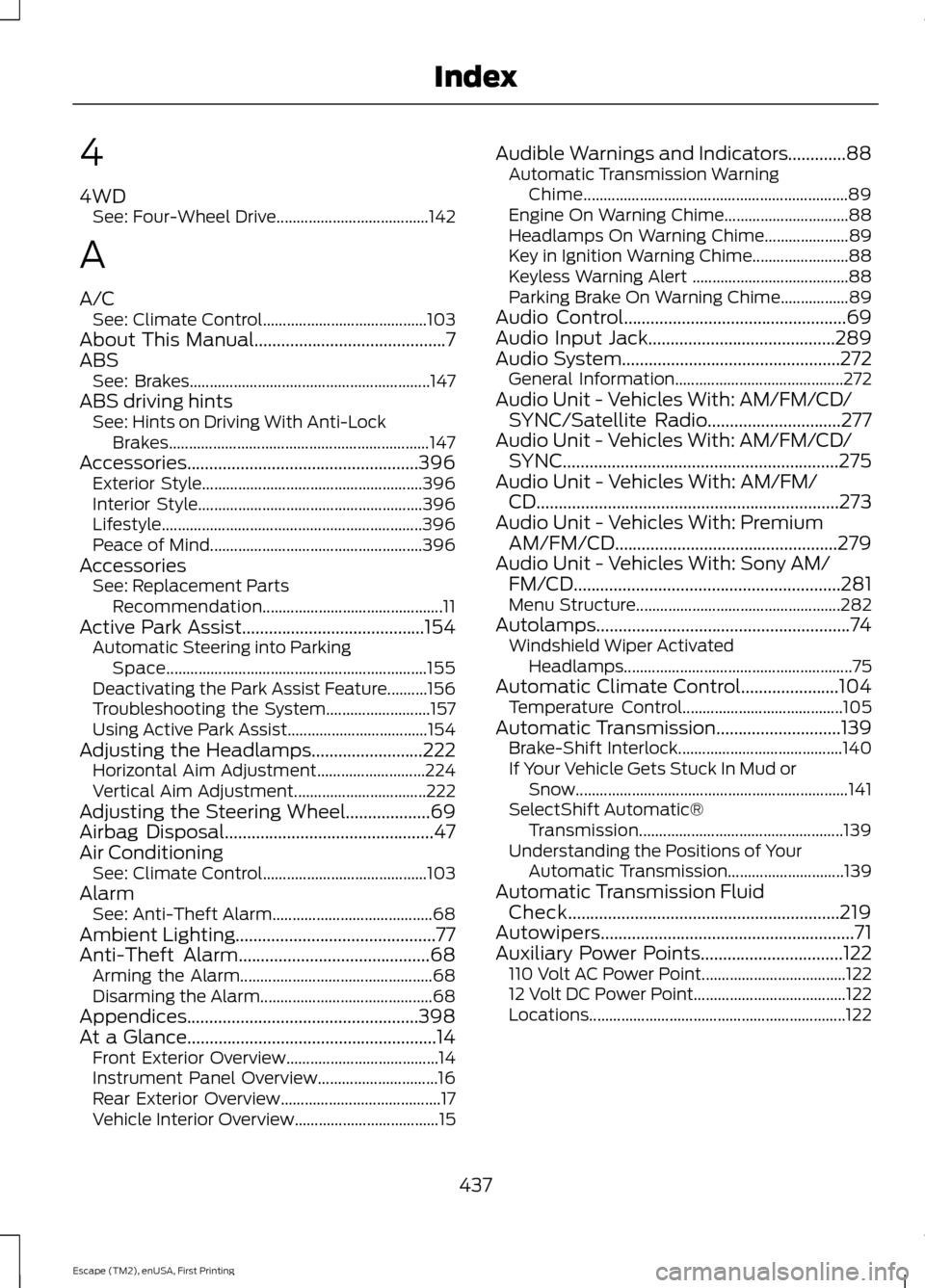
4
4WD
See: Four-Wheel Drive...................................... 142
A
A/C See: Climate Control......................................... 103
About This Manual...........................................7
ABS See: Brakes............................................................ 147
ABS driving hints See: Hints on Driving With Anti-Lock
Brakes................................................................. 147
Accessories....................................................396 Exterior Style....................................................... 396
Interior Style........................................................ 396
Lifestyle................................................................. 396
Peace of Mind..................................................... 396
Accessories See: Replacement Parts
Recommendation............................................. 11
Active Park Assist
.........................................154
Automatic Steering into Parking
Space................................................................. 155
Deactivating the Park Assist Feature..........156
Troubleshooting the System.......................... 157
Using Active Park Assist................................... 154
Adjusting the Headlamps
.........................222
Horizontal Aim Adjustment........................... 224
Vertical Aim Adjustment................................. 222
Adjusting the Steering Wheel...................69
Airbag Disposal...............................................47
Air Conditioning See: Climate Control......................................... 103
Alarm See: Anti-Theft Alarm........................................ 68
Ambient Lighting.............................................77
Anti-Theft Alarm
...........................................68
Arming the Alarm................................................ 68
Disarming the Alarm........................................... 68
Appendices....................................................398
At a Glance........................................................14 Front Exterior Overview...................................... 14
Instrument Panel Overview.............................. 16
Rear Exterior Overview........................................ 17
Vehicle Interior Overview.................................... 15Audible Warnings and Indicators.............88
Automatic Transmission Warning
Chime.................................................................. 89
Engine On Warning Chime............................... 88
Headlamps On Warning Chime..................... 89
Key in Ignition Warning Chime........................ 88
Keyless Warning Alert ....................................... 88
Parking Brake On Warning Chime.................89
Audio Control
..................................................69
Audio Input Jack..........................................289
Audio System.................................................272
General Information.......................................... 272
Audio Unit - Vehicles With: AM/FM/CD/ SYNC/Satellite Radio..............................277
Audio Unit - Vehicles With: AM/FM/CD/ SYNC..............................................................275
Audio Unit - Vehicles With: AM/FM/ CD....................................................................273
Audio Unit - Vehicles With: Premium AM/FM/CD
..................................................279
Audio Unit - Vehicles With: Sony AM/ FM/CD............................................................281
Menu Structure................................................... 282
Autolamps.........................................................74 Windshield Wiper Activated
Headlamps......................................................... 75
Automatic Climate Control......................104 Temperature Control........................................ 105
Automatic Transmission
............................139
Brake-Shift Interlock......................................... 140
If Your Vehicle Gets Stuck In Mud or Snow.................................................................... 141
SelectShift Automatic® Transmission................................................... 139
Understanding the Positions of Your Automatic Transmission............................. 139
Automatic Transmission Fluid Check.............................................................219
Autowipers.........................................................71
Auxiliary Power Points
................................122
110 Volt AC Power Point.................................... 122
12 Volt DC Power Point...................................... 122
Locations................................................................ 122
437
Escape (TM2), enUSA, First Printing Index
Page 449 of 449
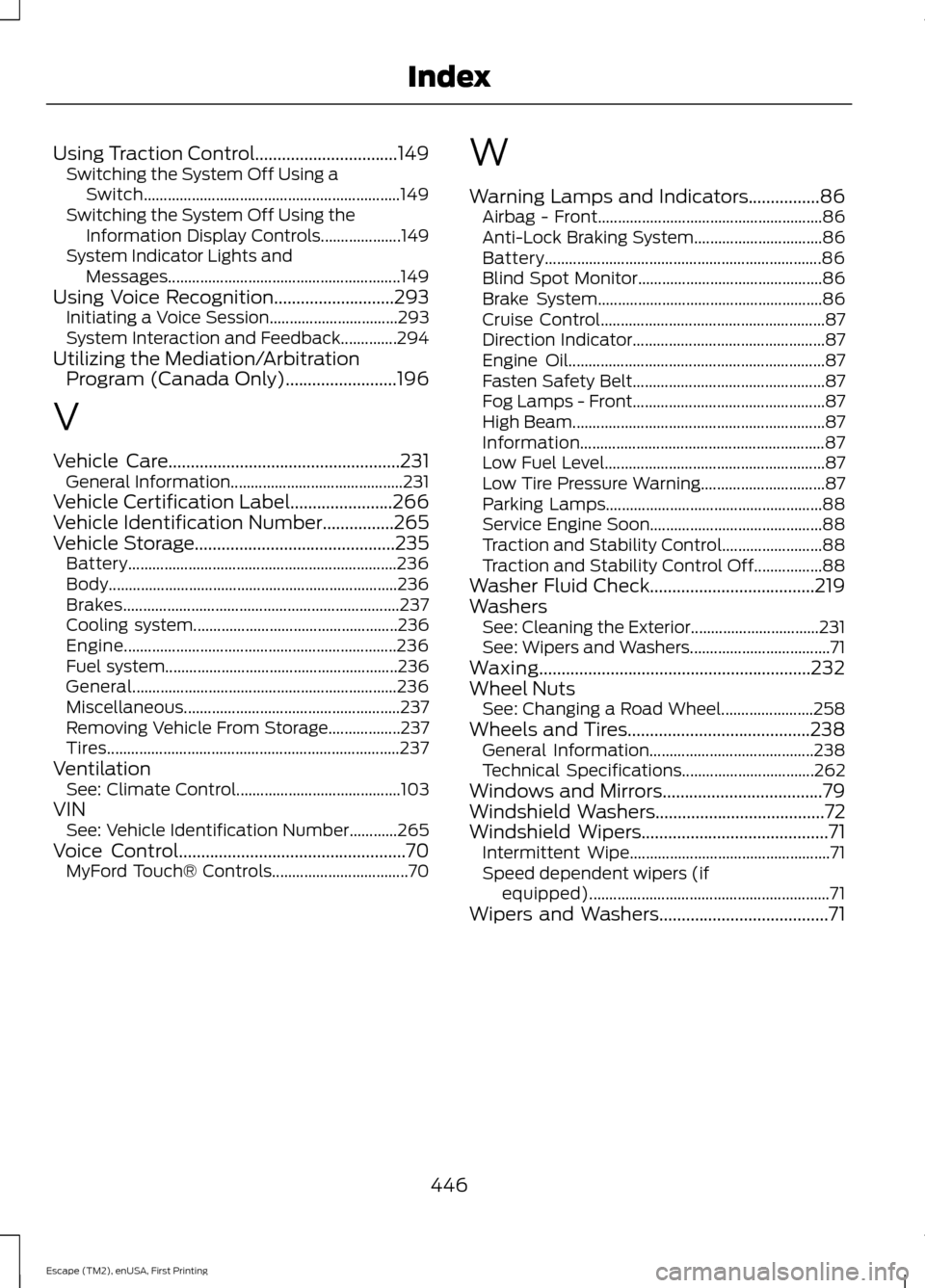
Using Traction Control................................149
Switching the System Off Using a
Switch................................................................ 149
Switching the System Off Using the Information Display Controls.................... 149
System Indicator Lights and Messages.......................................................... 149
Using Voice Recognition...........................293
Initiating a Voice Session................................ 293
System Interaction and Feedback..............294
Utilizing the Mediation/Arbitration Program (Canada Only).........................196
V
Vehicle Care
....................................................231
General Information........................................... 231
Vehicle Certification Label.......................266
Vehicle Identification Number................265
Vehicle Storage
.............................................235
Battery................................................................... 236
Body........................................................................\
236
Brakes..................................................................... 237
Cooling system................................................... 236
Engine.................................................................... 236
Fuel system.......................................................... 236
General.................................................................. 236
Miscellaneous...................................................... 237
Removing Vehicle From Storage.................. 237
Tires........................................................................\
. 237
Ventilation See: Climate Control......................................... 103
VIN See: Vehicle Identification Number............265
Voice Control...................................................70 MyFord Touch® Controls.................................. 70W
Warning Lamps and Indicators................86
Airbag - Front........................................................ 86
Anti-Lock Braking System................................ 86
Battery..................................................................... 86
Blind Spot Monitor.............................................. 86
Brake System........................................................ 86
Cruise Control........................................................ 87
Direction Indicator................................................ 87
Engine Oil................................................................ 87
Fasten Safety Belt................................................ 87
Fog Lamps - Front................................................ 87
High Beam............................................................... 87
Information............................................................. 87
Low Fuel Level....................................................... 87
Low Tire Pressure Warning............................... 87
Parking Lamps...................................................... 88
Service Engine Soon........................................... 88
Traction and Stability Control......................... 88
Traction and Stability Control Off.................88
Washer Fluid Check.....................................219
Washers See: Cleaning the Exterior................................ 231
See: Wipers and Washers................................... 71
Waxing.............................................................232
Wheel Nuts See: Changing a Road Wheel....................... 258
Wheels and Tires
.........................................238
General Information......................................... 238
Technical Specifications................................. 262
Windows and Mirrors....................................79
Windshield Washers
......................................72
Windshield Wipers..........................................71
Intermittent Wipe.................................................. 71
Speed dependent wipers (if equipped)............................................................ 71
Wipers and Washers......................................71
446
Escape (TM2), enUSA, First Printing Index